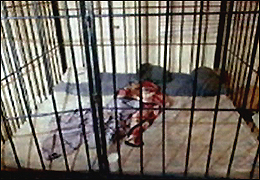
The kidnappings, beatings, and murders that mark the drug-related violence of Mexican border cities like Tijuana and Juarez have increasingly spilled over the border.
Emerging from the port of entry’s administrative offices into a sunny San Diego morning, Special Agent Dean Giboney spoke in fluent Spanish with the man whose temporary U.S. visa he had just helped renew. The man was smiling, happy to be out of Mexico, even though he understood that being on U.S. soil was no guarantee of safety from the Tijuana drug cartel that has put a price on his head.
|
The kidnappings, beatings, and murders that mark the extreme drug-related violence of Mexican border cities such as Tijuana and Juarez have increasingly spilled over the border. Agent Giboney is hoping the man—we’ll call him José —can provide information that will help in the Bureau’s efforts to dismantle the cartels and the criminal enterprises they fuel.
A few years ago, José started working for the Arellano Felix Organization (AFO) in Tijuana to earn extra money. But when he saw how routine the act of murder was for the cartel—leaders thought nothing of having even their own people killed for real or perceived insubordination—he started to fear for his life and contacted the FBI to help him flee the country.
Sources like José are just one of many ways the Bureau gathers intelligence to combat border crime. Agent Giboney is particularly interested in gaining information regarding fugitives in the Los Palillos case, one of San Diego’s most notorious examples of so-called “spillover violence.”
Los Palillos—the “Toothpicks”—was a rogue spinoff from the AFO. From 2004 to 2007, the San Diego street gang carried out a brutal crime spree in which 13 people were abducted and nine were killed. Bodies turned up in cars, on jogging paths, and inside houses in quiet, residential neighborhoods.
The group’s leader, Jorge Rojas-Lopez, is serving a life sentence without parole for the crimes, and several of his henchmen are also in prison. But five members of the gang are still at large.
Rojas-Lopez—a former AFO member—was fighting the cartel for a piece of the billion-dollar drug trade, but he was also fighting for revenge, because the AFO had ordered the murder of his brother.
“This level of extreme violence is very typical of the way the cartels operate south of the border,” Giboney said.Unfortunately, Los Palillos is not an isolated case north of the border, either.
What explains this level of brutality? “The cartels and the gang members they employ want to be Al Pacino in the movie Scarface,” Giboney said. During raids on the homes of cartel members, he has seen movie posters of the machine-gun-wielding Pacino, who played a vicious drug kingpin. “They want to live that lifestyle—the nice cars, going out to clubs, throwing money around. But once you’re in that lifestyle,” he explained, “it’s hard to get out, even if you want to.”
José understands how difficult it is to get away from the cartel. The “narcos,” as he calls AFO members, are powerful as well as ruthless, and their influence is felt at every level of Mexican society. “Whatever they want to know about you they can find out,” he said. “They will stop at nothing to protect their interests, even if it means crossing the border.”
Next: A Trip to Tijuana


No comments:
Post a Comment